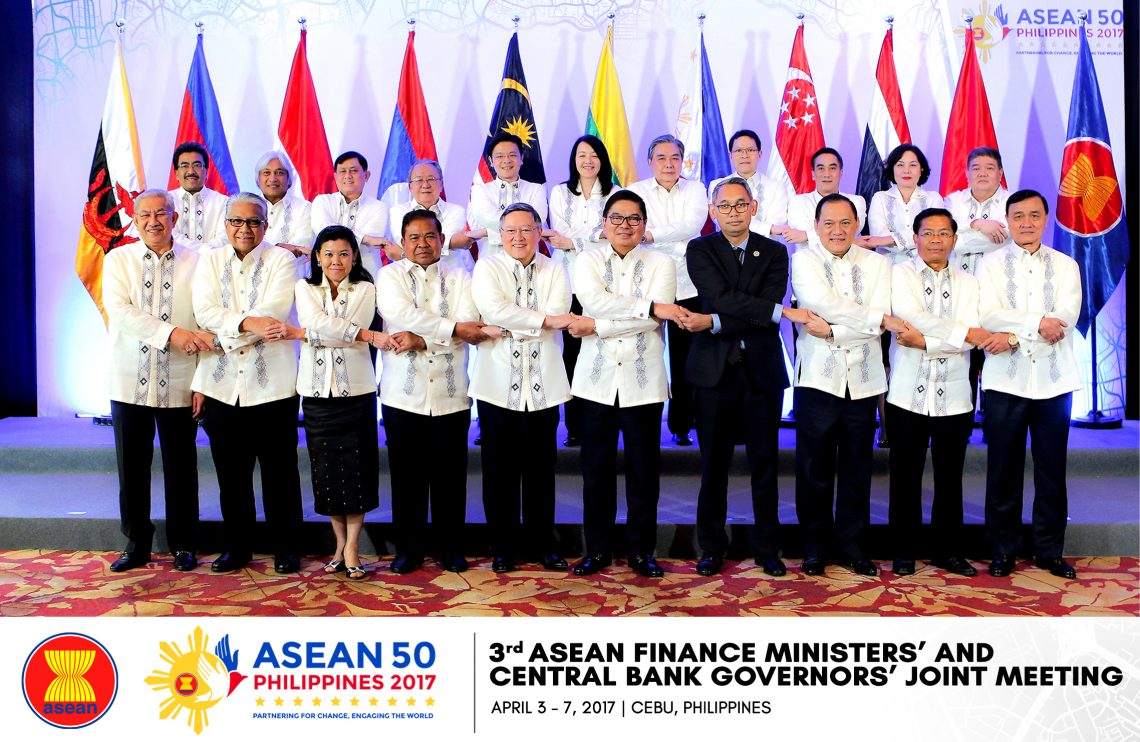We, the ASEAN Finance Ministers and Central Bank Governors, held the Joint Meeting of the ASEAN Finance Ministers and Central Bank Governors under the co-chairmanship of H.E. Carlos G. Dominguez III, the Secretary of Finance of the Philippines, and H.E. Amando M. Tetangco, Jr., Governor of the Bangko Sentral ng Pilipinas, in Cebu, the Philippines on 7 April 2017, coinciding with the occasion of the 50th anniversary of ASEAN, and declared that:
Economic Update and Policy Challenges
1. We remain steadfast in pursuing the goals of ASEAN to achieve a highly integrated and cohesive economy; that is competitive, innovative, and dynamic; with enhanced connectivity and sectoral cooperation; that is resilient, inclusive, people-oriented, and people-centred; and connected with the rest of the world. As such, we shall continue to promote economic growth, financial integration, strengthen financial stability, implement appropriate monetary, fiscal and macroprudential policies in our jurisdictions, and intensify financial cooperation to further advance our region’s resilience. We recognised that domestic demand will remain a key driver of our regional growth while structural reforms, public spending, and fiscal stimulus will support investments in ASEAN.
Download the full Statement Here.
- ABOUT ASEANThe Association of Southeast Asian Nations, or ASEAN, was established on 8 August 1967 in Bangkok, Thailand, with the signing of the ASEAN Declaration (Bangkok Declaration) by the Founding Fathers of ASEAN: Indonesia, Malaysia, Philippines, Singapore and Thailand. Brunei Darussalam joined ASEAN on 7 January 1984, followed by Viet Nam on 28 July 1995, Lao PDR and Myanmar on 23 July 1997, and Cambodia on 30 April 1999, making up what is today the ten Member States of ASEAN.Menu
- WHAT WE DO
ASEAN organs always strive to achieve ASEAN’s goals and objectives, the Secretary-General of ASEAN and the ASEAN Secretariat shall be functioned as coordinating Secretariat to help facilitate effective decision-making withing and amongst ASEAN bodies. In addition, each Member State shall appoint a Permanent Representative to liaise with Secretary-General of ASEAN and the ASEAN Secretariat
Menu - WHO WE WORK WITH
ASEAN shall develop friendly relations and mutually beneficial dialogues, cooperation and partnerships with countries and sub-regional, regional and international organisations and institutions. This includes external partners, ASEAN entities, human rights bodies, non-ASEAN Member States Ambassadors to ASEAN, ASEAN committees in third countries and international organisations, as well as international / regional organisations.
Menu - OUR COMMUNITIES
The rodmap for an ASEAN Community (2009-2015) was declared by the leaders in 2009. The ASEAN Community, anchored on three community pillars: Political-Security Community, Economic Community, Socio-Cultural Community was launched in 2015. The ASEAN 2025: Forging Ahead Together was introduced in 2015 as a Post-2015 Vision. It comprises the ASEAN Community Vision 2025, the ASEAN Political-Security Community Blueprint 2025, the ASEAN Economic Community Blueprint 2025 and the ASEAN Socio-Cultural Community Blueprint 2025
Menu - SITEMAP





